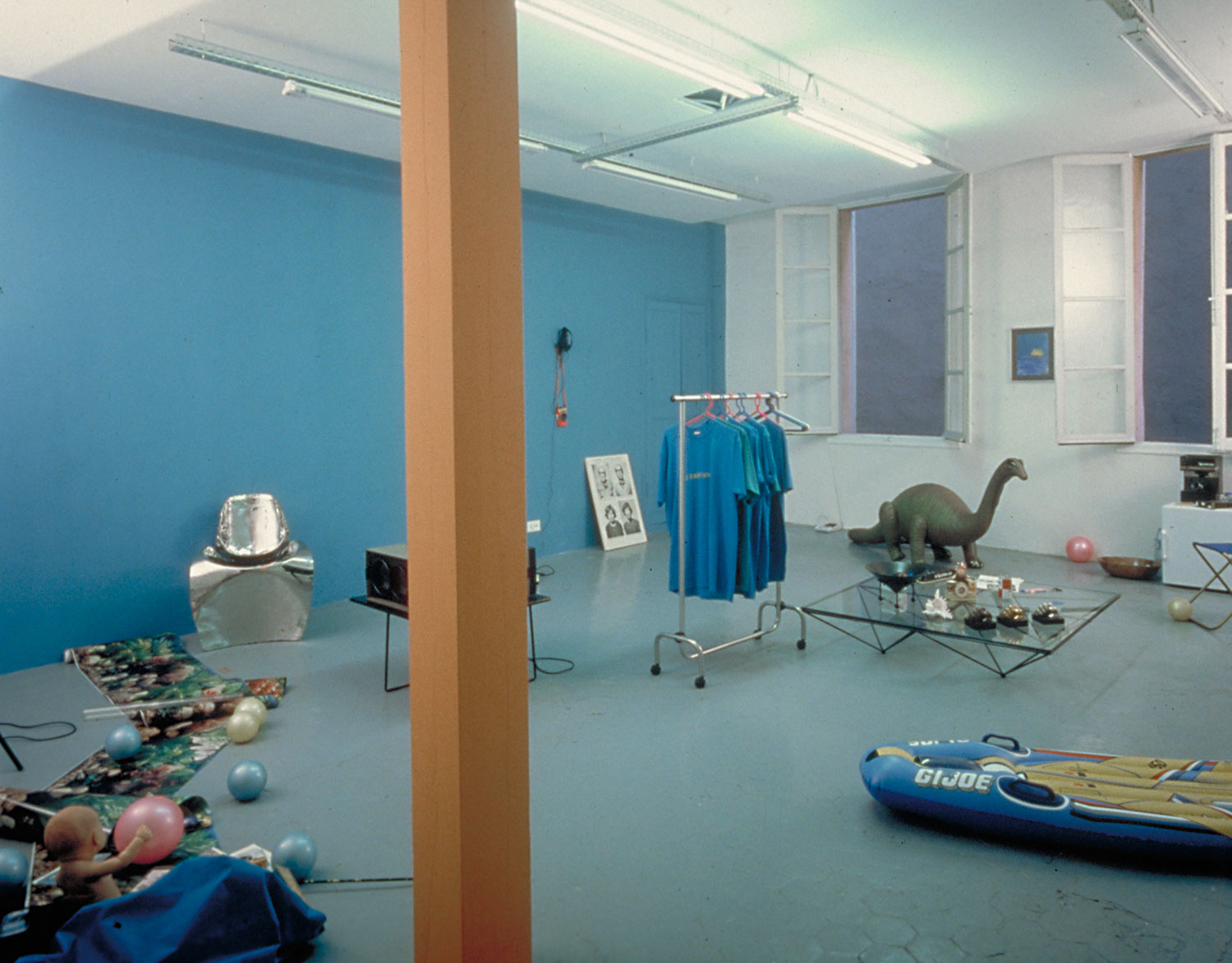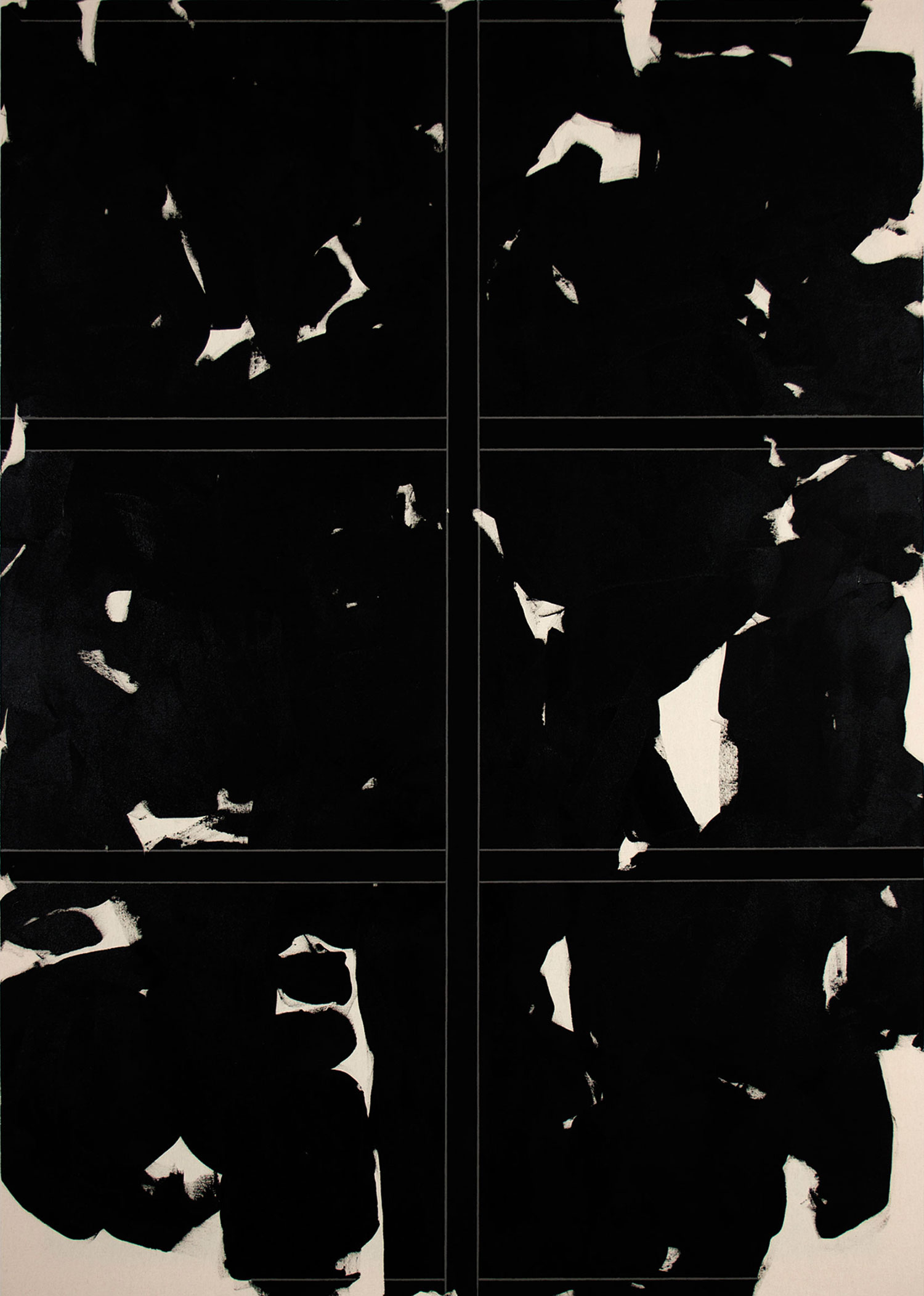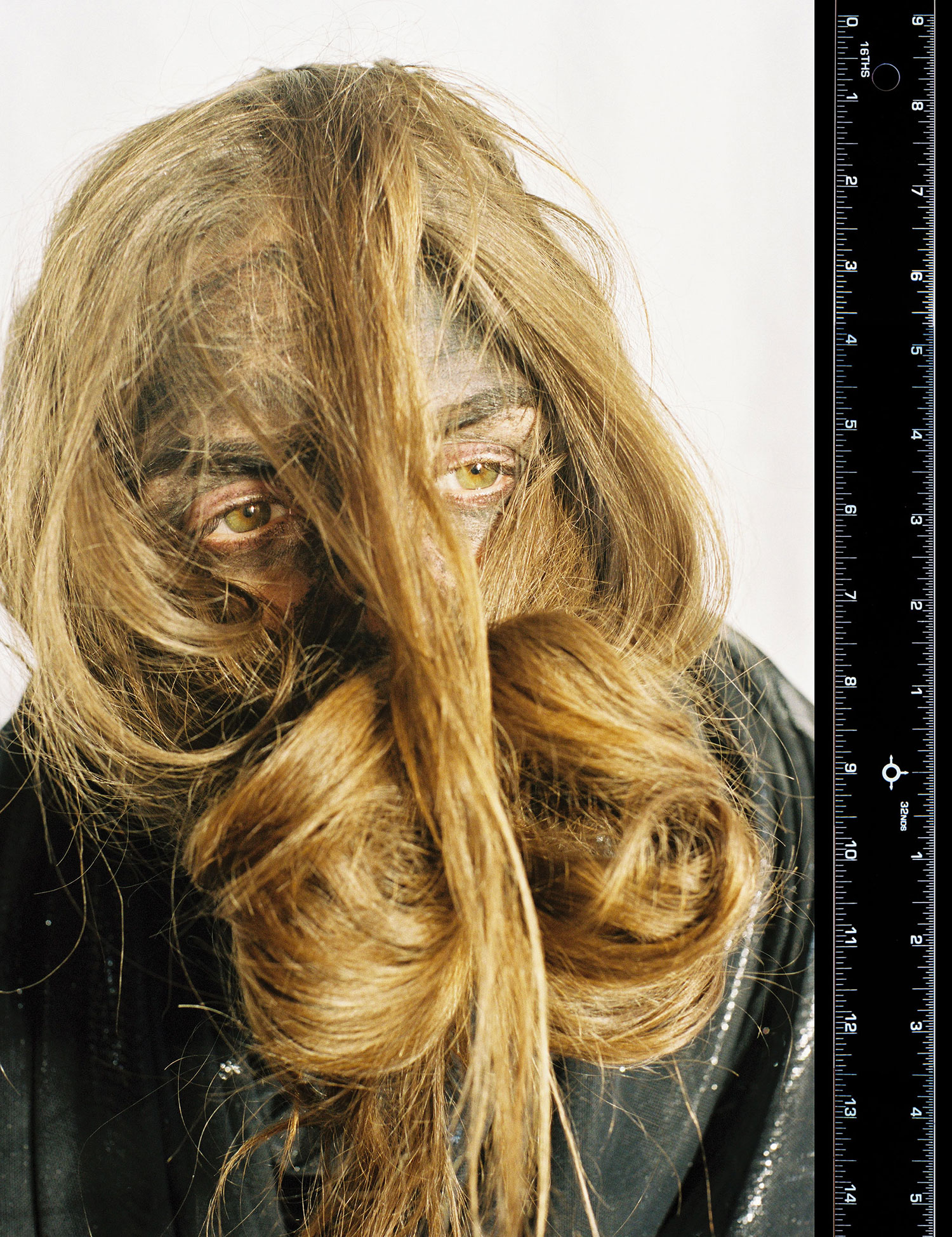
Appropriation is ubiquitous today — both as an artistic procedure and as a discourse. This discourse emerged in the late ’70s and early ’80s, applying the tropes of post-structuralism that were becoming popular at the time — such as the “death of the author” and the loss of any primary reality within a sea of representations or “simulacra” — to the work of a group that came to be known as the Pictures Generation.1 Critics like Douglas Crimp and Craig Owens identified in these artists’ work a critique of originality and authorship, effected through an analysis of the structure of representations and the functioning of image culture.
The practice of Aleksandra Domanovic can be seen in this tradition. Her work Anhedonia (2007), for example, is based on Woody Allen’s Annie Hall (1977), but swaps the entire image track of the film with a quick succession of stock footage from the Getty archive. The artist picked keywords from the original script (about one per grammatical sentence) to search Getty’s database. Juxtaposing the stock footage with the search terms, Anhedonia highlights the stereotypical, generic character of the material. Each sequence looks like we have seen it before — which may well be the case, since it is there to be “appropriated” by whoever pays the licensing fee.
Another artist working in this tradition is Candice Breitz. Breitz appropriates Hollywood films and music videos, which she then manipulates and re-edits. Four Duets (2000), for example, consists of four two-channel video installations. Each is based on a video of a female pop star performing a love song, cut up according to its lyrics, eliminating most of the material and leaving only the personal pronouns: “I/me/my” looped on one monitor, “you” on the other. Four Duets condenses each love song to its crucial structural components, not only revealing the basic and banal structure they share, but also the differences in fashion that distinguish the duets and locate each clearly in a certain historical moment. The work thus exposes the (re-)cyclical nature of mass culture that continually produces reiterations of the same. Mother + Father (2005) consists of two six-channel video installations with Hollywood actresses or actors performing stereotypes of motherhood or fatherhood respectively. They are isolated on a black background, foregrounding the similarities of their performances: The mothers are self-denying or hysterical; the fathers over-protective, on a mission to preserve their daughters’ virginity. The title Mother + Father and the particular choice of roles add another layer to the work: Hollywood movies, they suggest, fulfill the function of parents, teaching us values and norms. This is precisely the role of the culture industry2 according to critical theory: to condition our behavior, our desires and our thinking. According to this model, we learn what situations and problems we will encounter — for example learning one’s daughter is dating someone — and how to deal with them: how to feel, how to express these feelings, how to act but also what to wear, what beverage to drink and when to smoke a cigarette. Breitz’ work can be read along these lines — as has been the case with first-generation appropriation artists like Cindy Sherman or Barbara Kruger: as a critique of the culture industry’s effects on subjectivity.
The work of Oliver Laric however, sharing many formal characteristics and procedures with Breitz’ practice, introduces a shift of perspective and sheds a different light on the functioning of the culture industry’s products. His work Touch my Body (Green Screen Version) (2008) is based on a music video by Mariah Carey, clearly directed at a male adolescent audience, for whose objectifying gaze (embodied by the camera). Carey performs self-objectification quite literally: “Touch my body / Put me on the floor / Wrestle me around / Play with me some more / Touch my body / Throw me on the bed…” This objectification is heightened by Laric’s removal of the addressee of Carey’s lyrics in the video, who happens to be a male adolescent “computer nerd.” But by blanking him out, Laric makes the viewer the only and direct addressee of Carey’s enticements. Isolating the figure of Carey against a green background, Laric’s Green Screen Version literalizes the original’s invitation to viewers to project themselves. This is where Laric updates the familiar strategies of appropriation: the work consists not only of his manipulated, appropriated clip, but comprises a whole collection of different versions by different authors, each using Laric’s Green Screen Version to apply similar artistic operations of appropriation and manipulation to the material as Laric himself. The products of the culture industry appear here not as role models, but as raw material for the audience’s own artistic production. The neologism “prosumer” — an amalgamation of producer and consumer — captures this fundamental transformation of mass culture that has taken place over the past years. Everybody makes — in fact most of the material is appropriated — videos, photos and texts to exhibit them online. This artistic activity has become an important mode of the consumption or use of mass cultural products. Philosopher Boris Groys speaks of a new era of “mass artistic production” following that of mass art consumption.3

If this shift is already anticipated in some of Breitz’ works — such as Karaoke (2000), Legend, King or Queen (all 2005) in which she shows not the stars themselves, but fans impersonating them — it is directly addressed by Laric and several other emerging artists. For instance Matthias Fritsch’s TechnoViking Archive (2000-ongoing) compiles hundreds of unsolicited prosumer-made videos re-enacting — or otherwise representing and commenting on — his video Kneecam No.1 aka Technoviking (2000-11). After he had published the video on YouTube in 2006, it became extremely popular, counting over 30,000,000 views and more than 3000 so-called “video responses” — appropriation videos by other authors. For his Music from the Masses (2008-12), Fritsch creates silent video clips the duration of an average music video, then makes them available online. From the outset, the clips are produced as material to be used by others in their own work, the only condition being inclusion into Fritsch’s collection. Explicitly addressing his audience as prosumers, Fritsch’s détournement of Depeche Mode’s album title Music for the Masses (1987) captures spot-on the shift from consumption to prosumption.
Martin Kohout pushes the paradigm of prosumption to its logical conclusion. Watching Martin Kohout (2011) is a collection of 821 videos, published online as a YouTube channel. Each of the videos shows the artist staring slightly past the camera in silence, with a deadpan expression. Camera angle, composition and soundtrack suggest what is confirmed by the clips’ individual titles, Watching News, Watching Cocaine Bust Big Dildo, etc.; we witness the artist watching YouTube videos on his computer, documenting himself with the built-in webcam. Here, consumption and production fully coincide. As the viewer inscribes himself in the act of viewing, each act of viewing becomes a commentary, and each commentary becomes a work in its own right.
One might think that to professional artists the popularization of artistic procedures poses a threat. But in fact, the prosumer is not in competition with the professional artist, because they operate under fundamentally different paradigms: Art is made in order to be collected. Artists thus work under the paradigm of the archive, which is a highly exclusive principle.4 We know this principle from the Biblical narrative of Noah who, for his ark(ive), collected exactly two items of each species: one of each gender. It is the logic of the archive to collect difference — it is simply unnecessary to include in a collection something that it already contains. The archive thus makes the identical redundant, and produces innovation. Mass culture, on the other hand, is not made to be collected and preserved, but to be consumed. In other words, to be used and then discarded: It is made for the moment. The modern age, as we all know, is one of reproduction — be it mechanical or digital. Under these conditions, identity is much more easy to produce than difference. Since only the archive establishes the necessity to produce difference, there is no need for innovation in the realm of mass culture. Its products are consumed and re-appear again — for what is discarded can also be recycled. Breitz’ Four Duets pointedly demonstrates this re-cyclical nature of mass culture, as does a passage in Oliver Laric’s Versions (2010) that juxtaposes scenes from different Disney animation movies, revealing that cartoons such as Winnie the Pooh were copied from the studio’s earlier hits: the characters perform identical movements, interactions, slap-sticks. The transition from mass cultural consumption to mass artistic production in itself doesn’t affect this fundamental difference. Mass culture, after all, has always been produced by artistic means — that the “artists” are no longer only large Hollywood studios, but also dispersed prosumers doesn’t matter in this regard. Repetition remains the principle of mass cultural production — whether it is profit-driven as in Hollywood, or playful as part of mass cultural prosumption.

One can nevertheless identify within the realm of art specific tendencies responding to, or at least coinciding with, the appearance of the prosumer. While artists traditionally make art in order to be collected, there is a tendency now to collect works made by others. When presenting the whole collections of prosumer-made works, preserving the integrity and authorship of the individual items, the position these artists take tends towards that of a curator — they collect, compare and act as agents of the archive-function. The result is a striking accumulation of the almost the same — of variations or versions. Versions are the “same, but different” as Laric’s Versions has it, which simply means an acknowledgement of difference in ever greater nuances. The current celebration of versions — in all its versions from “fake” to “shanzhai”5 — as a new cultural paradigm participates in an anti-elitist undermining of the archive and that already drove the discourse around appropriation in the ’80s. For the archive, as we have seen, is a highly exclusive principle. It has long served as an extremely effective mechanism to limit and censor cultural production — or rather, to dismiss most cultural production as not innovative enough, and to discard it on the trash heap of history. Our democratic sensibility simply cannot tolerate the kind of discrimination that Noah applied when compiling his archive. If everybody is unique, everybody deserves to be archived — and if everybody is unique, the same must go for their artistic production (or prosumption). The discourse of versions is a compromise, reconciling modernity’s demand for innovation with the democratically motivated demand for equality and inclusion of all. While appropriation art and its discourse in the ’70s and ’80s highlighted the sameness of supposedly original images, today’s appropriationists identify difference in ever-greater nuances. The initial discourse of appropriation assumed that by revealing that every original is a copy, appropriation art would devalue the original. We know of course that in fact it produced further originals. What’s more, it demonstrated how originality is produced: not by creating original forms, but by using existing forms in an original way. When today’s appropriation artists celebrate the paradigm of “versions,” they appropriate the discourse of appropriation to invert its central claim: every copy is an original.
This logic, however, leads to an ever-increasing multiplication of cultural artifacts. Accordingly, the most celebrated archive of our time, the Internet, is in fact not an archive at all: no single instituted selection principle limits inclusion — it doesn’t collect, it accumulates. As long as we still assume that an artist addresses the archive, and thus works under a fundamentally different paradigm than the prosumer, the claim that every copy is an original would be merely symbolical. The question, however, is whether the anti-elitist undermining of the archive — already manifested in ’70s appropriation discourse — might in the meantime have succeeded.




